
A parabola (plural "parabolas"; Gray 1997, p. 45) is the set of all points in
the
plane equidistant from a given
line 
(the
conic section directrix) and a given
point

not on the line
(the
focus). The
focal
parameter (i.e., the distance between the directrix and focus) is therefore
given by

, where

is the distance from the vertex to the directrix or focus.
The
surface of revolution obtained by
rotating a parabola about its axis of symmetry is called a
paraboloid.

The parabola was studied by Menaechmus in an attempt to achieve
cube duplication. Menaechmus solved the problem
by finding the intersection of the two parabolas

and

. Euclid wrote
about the parabola, and it was given its present name by Apollonius. Pascal
considered the parabola as a projection of a
circle,
and Galileo showed that projectiles falling under uniform gravity follow
parabolic paths. Gregory and Newton considered the
catacaustic properties of a parabola that bring
parallel rays of light to a focus (MacTutor Archive), as illustrated above.
For a parabola opening to the right with vertex at (0, 0), the equation in
Cartesian coordinates is
 |
(1)
|
 |
(2)
|
 |
(3)
|
 |
(4)
|
The quantity

is known as the
latus rectum. If the vertex is at

instead of (0,
0), the equation of the parabola is
 |
(5)
|
If the parabola instead opens upwards, its equation is
 |
(6)
|
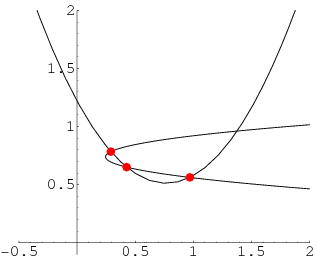
Three points uniquely determine one parabola with directrix parallel to the

-axis and one
with directrix parallel to the

-axis. If these
parabolas pass through the three points

,

, and

, they are
given by equations
 |
(7)
|
and
 |
(8)
|

In
polar coordinates, the equation of a
parabola with parameter

and center (0,
0) is given by
 |
(9)
|
(left figure). The equivalence with the Cartesian form can be seen by setting
up a coordinate system

and plugging
in

and

to obtain
 |
(10)
|
Expanding and collecting terms,
 |
(11)
|
so solving for

gives (◇). A
set of confocal parabolas is shown in the figure on the right.
In
pedal coordinates with the
pedal point at the
focus,
the equation is
 |
(12)
|
The parabola can be written parametrically as
or
A segment of a parabola is a
Lissajous
curve.
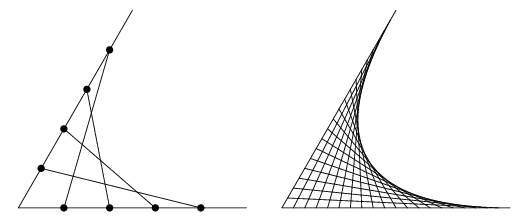
A parabola may be generated as the envelope of two concurrent line segments
by connecting opposite points on the two lines (Wells 1991).
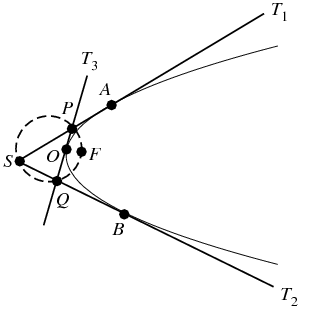
In the above figure, the lines

,

, and

are tangent to
the parabola at points

,

, and

, respectively.
Then

(Wells 1991).
Moreover, the
circumcircle of

passes through
the
focus 
(Honsberger
1995, p. 47). In addition, the foot of the perpendicular to a tangent to a
parabola from the
focus always lies on the tangent at
the vertex (Honsberger 1995, p. 48).
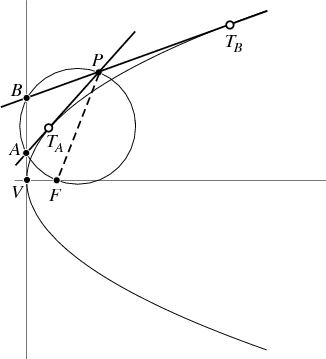
Given an arbitrary point

located
"outside" a parabola, the tangent or tangents to the parabola through

can be constructed by drawing the
circle having

as a
diameter, where

is the
focus. Then locate the points

and

at which the
circle cuts the
vertical tangent through

. The points

and

(which can
collapse to a single point in the degenerate case) are then the points of
tangency of the lines

and

and the
parabola (Wells 1991).
The
curvature,
arc
length, and
tangential angle are
The
tangent vector of the parabola is
The plots below show the normal and tangent vectors to a parabola.
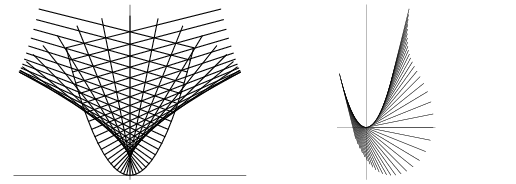 Wolfram
Wolfram











댓글 없음:
댓글 쓰기